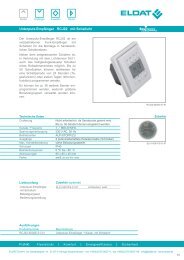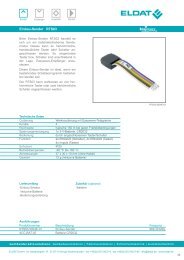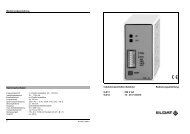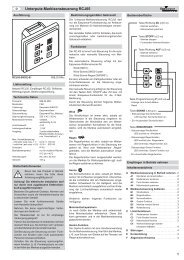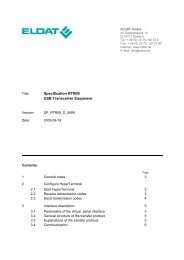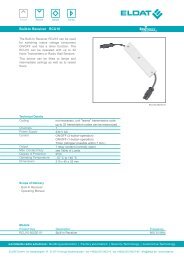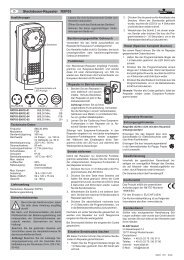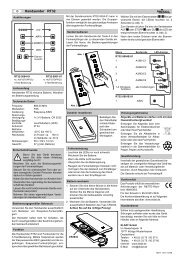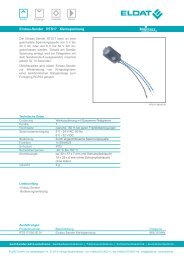Specification of RTRM08 Transceiver Module Easywave I2C - ELDAT
Specification of RTRM08 Transceiver Module Easywave I2C - ELDAT
Specification of RTRM08 Transceiver Module Easywave I2C - ELDAT
Create successful ePaper yourself
Turn your PDF publications into a flip-book with our unique Google optimized e-Paper software.
<strong>Specification</strong><br />
Index 1.01<br />
Project No.<br />
RF-Products, Controller <strong>RTRM08</strong> <strong>Transceiver</strong> <strong>Module</strong> Easw I 2 C Page 22<br />
Development<br />
Production S. Schreiber 2007-08-24<br />
The master can abort the procedure before an <strong>Easywave</strong> telegram is learned by setting the RX_MODE<br />
register to any value unequal to the LN_RQ or LN_PL value.<br />
Delete Learned <strong>Easywave</strong> Telegrams<br />
The RX_MODE register must be set to the DELLN value. The / REQ output is always inactive (high).<br />
When the DELLN value is written into RX_MODE register, the transceiver module immediately deletes the<br />
learned <strong>Easywave</strong> telegram <strong>of</strong> the channel which is specified by the RX_CHANNEL register.<br />
The transceiver module clears the appropriate bit in the bit mask <strong>of</strong> the RX_LN_CH0_7, RX_LN_CH8_15,<br />
RX_LN_CH16_23, and RX_LN_CH24_31 registers to indicate that the channel is no longer used. If the<br />
channel was not used before, the entire procedure described in this paragraph has not any effect.<br />
A master should perfom the following steps if it wants to delete a learned <strong>Easywave</strong> telegram:<br />
• Set the RX_MODE register to the PWD or PWD_RST value. This prevents the transceiver module from<br />
modifying the RX_CHANNEL register.<br />
• Set the RX_CHANNEL register appropriately. The master can determine an used channel by reading the bit<br />
mask from the RX_LN_CH0_7, RX_LN_CH8_15, RX_LN_CH16_23, and RX_LN_CH24_31 registers.<br />
• Set the RX_MODE register to the DELLN value.<br />
Transmitting <strong>of</strong> <strong>Easywave</strong> Telegrams<br />
The transceiver module has 32 built-in <strong>Easywave</strong> telegrams which it can transmit.<br />
A write access to the TX_ACK register initiates transmitting <strong>of</strong> an <strong>Easywave</strong> telegram with the channel <strong>of</strong> the<br />
TX_CHANNEL register and the button number <strong>of</strong> the TX_BUTTON register. The TX_ACK register also can be<br />
written in a single write transfer with the other mentioned registers. The transceiver module does the<br />
following:<br />
• The transceiver module switches its transceiver on and transmits a fixed count <strong>of</strong> <strong>Easywave</strong> telegrams<br />
regardless <strong>of</strong> the content <strong>of</strong> the RX_MODE register. The / REQ output and the status bits in the RX_STATUS<br />
register remain on their state. As long as the transceiver transmits, the TX_TRANSMIT-bit in the<br />
TX_STATUS register is 1. While the transceiver transmits, further writes into the TX_ACK register have not<br />
any effect. The master has to check the TX_TRANSMIT-bit in the TX_STATUS register whether it can<br />
initiate a desired transmission <strong>of</strong> a further <strong>Easywave</strong> telegram.<br />
• When the transceiver has finished transmitting <strong>of</strong> telegrams, it switches its transceiver on (receive) or <strong>of</strong>f<br />
according to the RX_MODE register and continues operation as specified by the RX_MODE register. The<br />
TX_TRANSMIT-bit in the TX_STATUS register is 0 now.<br />
The yellow LED lights as long as the transceiver transmits. (The LED is drawn on Figure 1 on page 4).<br />
7007



